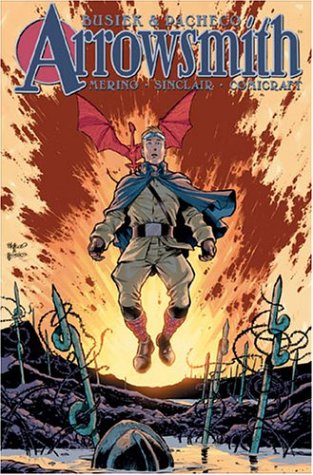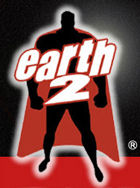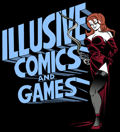| Arrowsmith
I came
to Kurt Busiek’s writing somewhat late, never actually
having read any of his superhero work, but falling crushingly
in love with his Astro City stories when I began
collecting the trades, which in turn lead me to go back
and collect Marvels, the book that brought photo-realistic
artwork and untraditional superhero storytelling (not to
mention Alex Ross) to fame and popularity in the mid nineties.
I loved
Busiek’s writing, because no matter the impossibility
of the material, namely men and women flying around in tights,
his stories were always firmly grounded in the man sans
the super. Marvels was told by one man, showing
through his eyes the way the world changed with the introduction
of icons like Spider-man and the Fantastic Four. Astro
City uses superheroics merely as a backdrop for Busiek
to set his characters against, never really relying on crafting
a single superhero continuity, but telling multiple stories
with the city as a character that the protagonists have
to contend with. You can even tell in the way the collections
are…er- collected: Family Album is a collection
of shorter pieces, focusing on the theme of “family”
and how it affects, or vice-versa, the world of superheroes,
while Tarnished Angel, following only one protagonist
throughout, is more about the journey of redemption than
a retired supervillain. I was happily amazed at how good
Busiek’s writing was, so I went to find his other,
more mainstream work.
And boy did I hate it.
Most
of it is for Marvel, and everything from Avengers
to Untold Tales of Spider-Man just bored me to
tears. I’ve never had much love for Marvel characters
outside of the X-Men, and without more character
driven stories to entice me, Busiek’s mainstream work
left me underwhelmed and uninterested; suffice it to say,
I’m not Fanboy enough to enjoy JLA/Avengers.
But
one title did catch my interest: Avengers Forever,
a maxi-series where Rick Jones (Marvel character hanger-on
and go-to-hostage) was able to change reality and a whole
bunch of Avengers had to help him out. I mention this because
that book was where I saw Busiek collaborating with current
artistic partner Carlos Pacheo, doing great artwork on well-constructed
scripts. They have renewed this pairing with their recent
work on Wildstorm’s Arrowsmith.
The
year is 1915 and more and more reports are coming from Europe
of war and the desperate need for troops to fight back the
Prussian and Tyrolian-Hungarian hordes. As their armies
spread further into and around Europe, the hordes use vampire
squads and fire giants to break through Allied lines and
weaken the magically bolstered defenses of the Gallic and
Britanian forces. The news even reaches the small town of
Herbertsville, Connecticut in the United States of Columbia,
and the even smaller ears of Fletcher Arrowsmith, who is
more than willing to volunteer and seek his destiny in the
Overseas Aero Corps, learning the spells to fly and becoming
an elite airman.
Despite
his father’s stark lack of approval of fighting a
European war, Fletcher sneaks off and enlists. What follows
is Fletcher’s journey as he learns about being a wizard,
and about the true and harsh terrors of war, losing loved
ones and possibly hope along the way.
Alternate
history is a hard genre to write well. While we’ve
all read (and loved, if you were me) What If? comics,
reading about the alternate lives of our favorite heroes
when one thing was changed (Daredevil raised by Kingpin,
Spider-man never gets bitten, etc.), those were situations
where only a minor detail of history was changed. When you
delve a little deeper and change something on a larger scale,
like making magic real and viable in our world, the entire
world is affected, not just a single character. How would
the settlement of North America have gone if the Native
Americans could summon giant bears and ogres to attack colonists?
What would the Civil War have been like with flying dragon
cavalry? It’s much harder to write that kind of world,
and we often see it fail rather miserably in comics, with
books like Alternation and Steampunk.
Busiek
clearly did a mountain of research on the book, even tapping
(the non-dirty kind) and thanking author Lawrence Watt-Evans
for helping to flesh out the 1100 years of socio-economic
history of his alternate world. You wouldn’t think
that a trench warfare scene that features a fire giant,
pixies, and French soldiers could seem authentic, but it
does, due in part to Busiek’s decision to leave the
dialogue French (Gallic) soldiers or German (Prussian) written
in their native tongue, letting the actions tell the story
as easily as the words might.
The
details show in the drawing up of new maps, as the countries
we’ve come to know and argue with at U.N. meetings
have all changed. The U.S. is the U.S.C, and is maybe half
the size it is now, while France is Gallia (probably stemming
from it’s old Roman name Gaul). Russia appears divided
into Novgorod and Muscovy, while Polonia occupies Poland’s
usual continental seat. It quite literally is a whole new
world, and Busiek has not stopped exploring it; in fact,
he has barely touched on the changes of this world, as he
spends most of his writing time on Fletcher and World War
I. All of this “guess which country” is merely
background for the real story, and if the background is
this detailed, the story is usually just as good.
And
it is. Busiek is writing a good war story, despite the fantastic
elements, and has created a true Joseph Campbell-esque hero
in Fletcher Arrowsmith, and to add to that, he is also capturing
the feel of World War I while making it his own war. The
controversy over even entering WWI was a very large hullabaloo
in the U.S. then, with many seeking to stay out of the war
as it concerned only Europe and not U.S. interests. This
is as true of Fletcher’s world as it was in ours,
as demonstrated by his father’s forbidding Fletcher
to join up. More than one American lad lied about his age
to enlist, filled with notions of glory and honor, believing
that there was something more relevant than the tangled
system of international treaties that spawned this war.
Busiek does a great job of setting up Fletcher for the awakening
his character must go through: i.e. learning that war is
never glorious, just bloody, as he witnesses atrocity after
atrocity befall friend and enemy alike.
Some
of those atrocities occur as a direct result of dangerous
use of magic, which continues to echo WWI, as the great
leaps in weapons technology that were made (machine guns,
chemical weapons like mustard gas, barbed wire trenches)
resulted in the highest known death toll at that point in
history. The wizards concocting dangerous new magics are
analogs to the scientists of the time period, and Busiek
uses them to comment on the historical mistakes that were
made. The feeling of disillusionment that WWI created, the
one that spawned the likes of Hemingway and the rest of
the Lost Generation writers, is felt throughout the book.
Yet Busiek never loses sight of the bigger story while telling
us Fletcher’s personal tale.
Carlos
Pacheo is one of those great artists that isn’t known
for a certain style like Michael Avon Oeming or Sam Kieth;
he’s just a damn good, solid artist. He’s not
flashy, but he is perfect because he fits whatever book
he happens to be penciling. All the human characters of
the book are simple, straight-forwardly drawn. There’s
no exaggeration of facial features, only minute details
that help us distinguish characters and expressions of emotions.
Normally, I would call this facial sameness, but here, the
art seems to have a purpose or two: the first being that
the reader has to look carefully at the artwork, making
him or her slow down and pay attention to infer the meaning,
and it also seems to contrast against the non-human characters
and their more overstated character designs.
Pacheo
really put work into character design for the various creatures
of this magic world: rock trolls, ogres, fairies, red caps,
dragons, salamanders, etc. Each one is detailed and well
drawn, and possessed of some odd realistic qualities that
allow them to fit-in next to the humans in a panel and not
seem out of place, merely different. His architectural work
is expert and on par with Bryan Hitch, as is his use of
splash pages and panels when Pacheo is demonstrating some
of the more powerful affects of magic in this world. Pacheo
is one of the under-sung talents of the industry, and well
worth repeat viewings.
This
is a great book and much deserving of your time and cash.
For $14.95, you get the first six issues of the series along
with the eight-page preview that was solicited. It’s
rare enough that you find good alternate history storytelling
outside the likes of Harry Turtledove, but even less likely
is finding good war fiction coupled with it. And honestly,
this isn’t our World War I: it could go either way
with all that magic artillery flying (sometimes crawling)
around, and I can’t wait for the next volume.
So
Smart in Their Fine Uniforms (Arrowsmith, Book 1)
|






